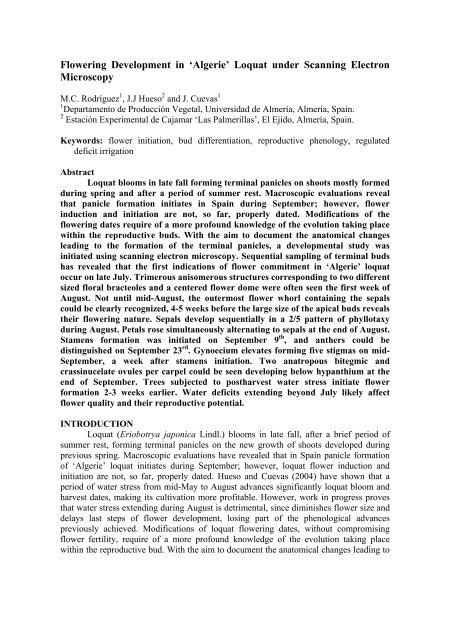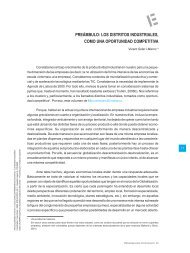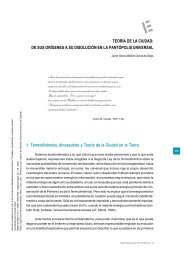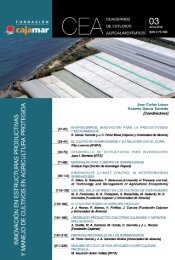Flowering Development in 'Algerie' Loquat under Scanning Electron ...
Flowering Development in 'Algerie' Loquat under Scanning Electron ...
Flowering Development in 'Algerie' Loquat under Scanning Electron ...
Create successful ePaper yourself
Turn your PDF publications into a flip-book with our unique Google optimized e-Paper software.
<strong>Flower<strong>in</strong>g</strong> <strong>Development</strong> <strong>in</strong> ‘Algerie’ <strong>Loquat</strong> <strong>under</strong> Scann<strong>in</strong>g <strong>Electron</strong><br />
Microscopy<br />
M.C. Rodríguez 1 , J.J Hueso 2 and J. Cuevas 1<br />
1 Departamento de Producción Vegetal, Universidad de Almería, Almería, Spa<strong>in</strong>.<br />
2 Estación Experimental de Cajamar ‘Las Palmerillas’, El Ejido, Almería, Spa<strong>in</strong>.<br />
Keywords: flower <strong>in</strong>itiation, bud differentiation, reproductive phenology, regulated<br />
deficit irrigation<br />
Abstract<br />
<strong>Loquat</strong> blooms <strong>in</strong> late fall form<strong>in</strong>g term<strong>in</strong>al panicles on shoots mostly formed<br />
dur<strong>in</strong>g spr<strong>in</strong>g and after a period of summer rest. Macroscopic evaluations reveal<br />
that panicle formation <strong>in</strong>itiates <strong>in</strong> Spa<strong>in</strong> dur<strong>in</strong>g September; however, flower<br />
<strong>in</strong>duction and <strong>in</strong>itiation are not, so far, properly dated. Modifications of the<br />
flower<strong>in</strong>g dates require of a more profound knowledge of the evolution tak<strong>in</strong>g place<br />
with<strong>in</strong> the reproductive buds. With the aim to document the anatomical changes<br />
lead<strong>in</strong>g to the formation of the term<strong>in</strong>al panicles, a developmental study was<br />
<strong>in</strong>itiated us<strong>in</strong>g scann<strong>in</strong>g electron microscopy. Sequential sampl<strong>in</strong>g of term<strong>in</strong>al buds<br />
has revealed that the first <strong>in</strong>dications of flower commitment <strong>in</strong> ‘Algerie’ loquat<br />
occur on late July. Trimerous anisomerous structures correspond<strong>in</strong>g to two different<br />
sized floral bracteoles and a centered flower dome were often seen the first week of<br />
August. Not until mid-August, the outermost flower whorl conta<strong>in</strong><strong>in</strong>g the sepals<br />
could be clearly recognized, 4-5 weeks before the large size of the apical buds reveals<br />
their flower<strong>in</strong>g nature. Sepals develop sequentially <strong>in</strong> a 2/5 pattern of phyllotaxy<br />
dur<strong>in</strong>g August. Petals rose simultaneously alternat<strong>in</strong>g to sepals at the end of August.<br />
Stamens formation was <strong>in</strong>itiated on September 9 th , and anthers could be<br />
dist<strong>in</strong>guished on September 23 rd . Gynoecium elevates form<strong>in</strong>g five stigmas on mid-<br />
September, a week after stamens <strong>in</strong>itiation. Two anatropous bitegmic and<br />
crass<strong>in</strong>ucelate ovules per carpel could be seen develop<strong>in</strong>g below hypanthium at the<br />
end of September. Trees subjected to postharvest water stress <strong>in</strong>itiate flower<br />
formation 2-3 weeks earlier. Water deficits extend<strong>in</strong>g beyond July likely affect<br />
flower quality and their reproductive potential.<br />
INTRODUCTION<br />
<strong>Loquat</strong> (Eriobotrya japonica L<strong>in</strong>dl.) blooms <strong>in</strong> late fall, after a brief period of<br />
summer rest, form<strong>in</strong>g term<strong>in</strong>al panicles on the new growth of shoots developed dur<strong>in</strong>g<br />
previous spr<strong>in</strong>g. Macroscopic evaluations have revealed that <strong>in</strong> Spa<strong>in</strong> panicle formation<br />
of ‘Algerie’ loquat <strong>in</strong>itiates dur<strong>in</strong>g September; however, loquat flower <strong>in</strong>duction and<br />
<strong>in</strong>itiation are not, so far, properly dated. Hueso and Cuevas (2004) have shown that a<br />
period of water stress from mid-May to August advances significantly loquat bloom and<br />
harvest dates, mak<strong>in</strong>g its cultivation more profitable. However, work <strong>in</strong> progress proves<br />
that water stress extend<strong>in</strong>g dur<strong>in</strong>g August is detrimental, s<strong>in</strong>ce dim<strong>in</strong>ishes flower size and<br />
delays last steps of flower development, los<strong>in</strong>g part of the phenological advances<br />
previously achieved. Modifications of loquat flower<strong>in</strong>g dates, without compromis<strong>in</strong>g<br />
flower fertility, require of a more profound knowledge of the evolution tak<strong>in</strong>g place<br />
with<strong>in</strong> the reproductive bud. With the aim to document the anatomical changes lead<strong>in</strong>g to
the formation of the panicles, and with<strong>in</strong> them, the aris<strong>in</strong>g of the <strong>in</strong>dividual flower buds, a<br />
developmental study was <strong>in</strong>itiated us<strong>in</strong>g Scann<strong>in</strong>g <strong>Electron</strong> Microscopy. The objectives of<br />
this work are 1) date flower <strong>in</strong>itiation <strong>in</strong> ‘Algerie’ loquat grown <strong>in</strong> South East Spa<strong>in</strong>; 2)<br />
describe the process of flower differentiation <strong>under</strong> optimal grow<strong>in</strong>g conditions; 3)<br />
determ<strong>in</strong>e alterations <strong>in</strong> reproductive phenology due to the implementation of a regulated<br />
deficit irrigation (RDI) regime.<br />
MATERIAL AND METHODS<br />
Twenty four term<strong>in</strong>al buds of ‘Algerie’ loquat were sampled every week from the<br />
end of vegetative growth (mid-July) to bloom (mid-November). Collections were carried<br />
out at random from ma<strong>in</strong> spr<strong>in</strong>g shoots of six adult full-irrigated (≈7650 m 3 of water per<br />
year) and well-ma<strong>in</strong>ta<strong>in</strong>ed trees grow<strong>in</strong>g <strong>in</strong> the Experimental Station of Cajamar “Las<br />
Palmerillas” (latitude 36º48’N, longitude 2º43’W). With the aim to process the most<br />
representative and uniform samples for each date, the buds once collected were taken to<br />
the lab and ordered by size. Then, the four <strong>in</strong>termediate-sized buds were selected and<br />
immediately fixed <strong>in</strong> 3% glutaraldehyde <strong>in</strong> phosphate buffer, pH 7.2. Before observation<br />
the buds were partially dissected remov<strong>in</strong>g most external bracts <strong>under</strong> b<strong>in</strong>ocular, and<br />
subsequently dehydrated, critical po<strong>in</strong>t dried, sputter-coated with 20 nm gold, and f<strong>in</strong>ally<br />
observed <strong>under</strong> a Hitachi S-3000N Scann<strong>in</strong>g <strong>Electron</strong> Microscopy, mostly operated at 15-<br />
20 kV. Dur<strong>in</strong>g the last steps of flower development and when the floral nature of the buds<br />
was deduced from their large size and appearance, we chose to process the <strong>in</strong>dividual<br />
floral buds aris<strong>in</strong>g from the basal parts of the develop<strong>in</strong>g panicles, given their most<br />
advanced phonological stage. To determ<strong>in</strong>e the effects of regulated deficit irrigation on<br />
reproductive phenology samples were taken follow<strong>in</strong>g exactly the same procedure. RDI<br />
trees were irrigated as controls except dur<strong>in</strong>g a period of six weeks (from mid-June to the<br />
end of July) when water<strong>in</strong>g was suspended (for more details, see Cuevas et al., this<br />
volume). Precipitation <strong>in</strong> the area reaches an average of 231 mm, mostly dur<strong>in</strong>g fall and<br />
w<strong>in</strong>ter. No ra<strong>in</strong> occurred dur<strong>in</strong>g water stress period.<br />
RESULTS AND DISCUSSION<br />
Sequential sampl<strong>in</strong>g of term<strong>in</strong>al buds from the end of shoot growth to anthesis has<br />
revealed that the first <strong>in</strong>dications of flower <strong>in</strong>itiation <strong>in</strong> ‘Algerie’ loquat may be dated at<br />
the end of July. Vegetative buds characterized for a narrow conic shaped meristem<br />
predom<strong>in</strong>ate until mid-July (Fig. 1a). In the last week of July, three months and a half<br />
before bloom, a transitional stage <strong>in</strong> which the base of the apical meristem enlarges was<br />
recognized (Fig. 1b). This stage can be labeled as panicle <strong>in</strong>itiation. Rodriguez (1983)<br />
marks, also <strong>in</strong> Spa<strong>in</strong>, the end of July as the beg<strong>in</strong>n<strong>in</strong>g of bud differentiation <strong>in</strong> spr<strong>in</strong>g<br />
shoots. Formation of new nodes <strong>in</strong> shoots of ‘Algerie’ grown <strong>in</strong> SE Spa<strong>in</strong> ends <strong>in</strong> mid-<br />
July, although elongation of preformed nodes may extend shoot length until summer rest<br />
Cuevas et al. (1997). End of shoot growth is needed before the term<strong>in</strong>al bud differentiate<br />
<strong>in</strong>to panicle. L<strong>in</strong> et al. (1999) <strong>in</strong>form that <strong>in</strong> Zhejiang (Ch<strong>in</strong>a) <strong>in</strong>florescences beg<strong>in</strong> to<br />
differentiate ma<strong>in</strong> axes <strong>in</strong> the beg<strong>in</strong>n<strong>in</strong>g of August, while secondary axes are formed <strong>in</strong><br />
the middle or the end of August.<br />
Unequivocal floral structures were first observed dur<strong>in</strong>g the first days of August.<br />
In these days, trimerous anisomerous structures, correspond<strong>in</strong>g to two different-sized<br />
floral bracteoles and a centred flower dome, were often seen (Fig. 1c). Enlargement of a<br />
progressive more complex panicle bear<strong>in</strong>g multiple trimerous structures spirally disposed<br />
along the <strong>in</strong>florescence axis cont<strong>in</strong>ued dur<strong>in</strong>g August (Fig. 1d). At this time this bud is
still macroscopically labeled as undifferentiated and quiescent. One bracteole develops to<br />
a larger size than the opposite, differences that often perdure <strong>in</strong> time (Fig. 1c and d). Late<br />
form<strong>in</strong>g flowers at the base of more advanced meristem show, however, that the very<br />
early steps of bracteole formation is characterized for similar small lateral elevations.<br />
Both bracteoles are extremely hairy.<br />
The outermost flower whorl conta<strong>in</strong><strong>in</strong>g sepals could not be clearly recognized<br />
until mid-August (Fig. 2a), 5-6 weeks before the large size of the apical buds reveals<br />
macroscopically their flower<strong>in</strong>g nature. In Zhejiang (Ch<strong>in</strong>a) sepals and petals form at the<br />
beg<strong>in</strong>n<strong>in</strong>g of September (L<strong>in</strong> et al., 1999). Sepals form sequentially <strong>in</strong> a 2/5 pattern of<br />
phyllotaxy. Initially, the sepals kept large differences <strong>in</strong> size that correspond to the order<br />
of formation. All sepals are <strong>in</strong>itiated before any petals. Dur<strong>in</strong>g the next two weeks, the<br />
most evident anatomical changes were the growth of the five sepals and their curvature<br />
enclos<strong>in</strong>g <strong>in</strong>cipient petal <strong>in</strong>itiation (Fig. 2b). Mature sepals developed abundant hairs<br />
abaxially but not <strong>in</strong> their <strong>in</strong>ner surface. Five petals start to grow simultaneously at the end<br />
of August alternat<strong>in</strong>g <strong>in</strong> position with the sepals. At the end of their formation petals,<br />
mostly glabrous, became bifid. Differential development was often seen among <strong>in</strong>dividual<br />
flower buds of the panicle, some of then bear<strong>in</strong>g <strong>in</strong>cipient stamens, while others only<br />
showed floral bracteoles formed. Dur<strong>in</strong>g first samples dates the apex of the panicle<br />
seemed to be more advanced, although as flower development progresses basal flowers of<br />
the panicle superseded the apical flowers.<br />
Stamens were <strong>in</strong>itiated on September 9 th , as small protuberances with<strong>in</strong> limits<br />
marked by a r<strong>in</strong>g of still very small petals (Fig. 2c). Anthers could be clearly<br />
dist<strong>in</strong>guished on September 23 rd , more or less when such developmental stage occurs <strong>in</strong><br />
Ch<strong>in</strong>a (L<strong>in</strong> et al., 1999). Although anthers could be recognized <strong>in</strong> mid-September,<br />
filament’s ris<strong>in</strong>g occurs late <strong>in</strong> development (Fig 2d). Stamens of equal height arise from<br />
the same distance to the center of the meristem, but as they grow some anthers displace<br />
others and become alternant <strong>in</strong> two whorls, so first r<strong>in</strong>g partially overlaps the second one.<br />
Filaments rema<strong>in</strong> adnate <strong>in</strong> a s<strong>in</strong>gle whorl. Anthers are dorsifixed and <strong>in</strong>trorse and split<br />
longitud<strong>in</strong>ally. Individual pollen gra<strong>in</strong>s were occasionally seen <strong>in</strong> broken anthers on<br />
October 21 st , 27 days before anthesis.<br />
Gynoecium elevated form<strong>in</strong>g five called-to-be stigmas after mid-September, a<br />
week after stamens <strong>in</strong>itiation. When styles rise, they leave the center of the meristem<br />
empty, what can be perceived as a depression (Fig 3a). Pistils f<strong>in</strong>ish their growth below<br />
anthers level, which partially cover stigmas. Six pistils per flowers were rarely detected.<br />
Two ovules per carpel could be seen at the end of September develop<strong>in</strong>g below a shortly<br />
campanulate hypanthium follow<strong>in</strong>g axial placentation (Fig. 3b and c). <strong>Loquat</strong> ovules are<br />
anatropous, bitegmic and crass<strong>in</strong>ucellate. Inner tegument form<strong>in</strong>g a r<strong>in</strong>g around nucellus<br />
is seen <strong>in</strong> immature ovules the first week of October, more than one month before bloom<br />
(Fig. 3c). Ovules seemed to be completely formed before petals aperture (Fig. 3d). A<br />
well-developed common obturator for each two ovules was clearly visible some days<br />
before bloom (Fig 3e). The ten ovules arrange radially (Fig. 3f).<br />
Trees subjected to postharvest water stress <strong>in</strong>itiate flower formation about three<br />
weeks earlier. Flower <strong>in</strong>itiation anticipation <strong>under</strong> deficit irrigation was ma<strong>in</strong>ta<strong>in</strong>ed along<br />
flower development process until bloom, without consistent differences. Water-stressed<br />
trees bloomed 26 days before than controls (Cuevas et al., this volume). Water deficits<br />
extend<strong>in</strong>g beyond July likely affect flower quality and their reproductive potential.
ACKNOWLEDGEMENTS<br />
Research partially funded by UE FEDER funds through projects AGL 2002-1108<br />
and AGL-2005-03972 from the Spanish M<strong>in</strong>istry of Education and Science. Esmeralda<br />
Ureña made a wonderful work with the SEM and we are deeply <strong>in</strong> debt with her.<br />
Literature Cited<br />
Cuevas, J., Gavilán, J. and Lorente, N. 1997. Fenología del níspero japonés (cv.<br />
‘Algerie’) en la Costa de Almería. Actas de Horticultura, 15:490-495.<br />
Hueso, J.J. and Cuevas. J. 2004. Deficit irrigation effects on flower<strong>in</strong>g of loquat. Options<br />
méditerranéennes Serie A 58:105-108.<br />
L<strong>in</strong>, S., Sharpe, R.H. and Janick, J. 1999. <strong>Loquat</strong>: Botany and Horticulture. Hort. Rev.<br />
23:233-277.<br />
Rodríguez, A. 1983. El cultivo del níspero en el valle del Algar-Guadalest. Ed. Soc.<br />
Coop. de Crédito de Callosa d’En Sarrià, Alicante 262 pp.<br />
Figures<br />
A<br />
C<br />
D<br />
B B<br />
B<br />
D<br />
Fig. 1. Flower <strong>in</strong>itiation <strong>in</strong> “Algerie” loquat. A) Vegetative meristem. B) Transitional<br />
stage. C) Trimerous forms correspond<strong>in</strong>g to first unequivocal floral structures. D)<br />
Panicle <strong>in</strong> formation. B: Bracteole. D: Flower dome. Bar A=500 µm; B-C=100 µm;<br />
D=1 mm.<br />
D
A<br />
C<br />
S S<br />
B S S B<br />
S<br />
St<br />
S<br />
P<br />
Fig. 2. Flower development <strong>in</strong> ‘Algerie’ loquat. A) Sepals formation. B) Petals <strong>in</strong>ception.<br />
C) Stamens <strong>in</strong>itiation. D) Anther and filament. B: Bracteole. S: Sepal. P: Petal. St:<br />
stamen. Bar=100 µm.<br />
B<br />
D<br />
D<br />
St<br />
S<br />
P
A<br />
C<br />
E<br />
Pt<br />
Ob<br />
Pt<br />
Ov<br />
Fig. 3. Gynoecium development <strong>in</strong> “Algerie” loquat. A) Stigmas elevation. B) Ovule<br />
primordia <strong>in</strong>ception. C) Immature ovules show<strong>in</strong>g <strong>in</strong>teguments and nucellus. D)<br />
Mature ovule; micropyle is visible. E) Obturator. F) Ovules arrangement. Pi: Pistils.<br />
Ov: Ovules. Ob: Obturator. Some organs were removed to allow vision of <strong>in</strong>ner<br />
structures. Bar=100 µm, except F where bar=500 µm.<br />
B<br />
D<br />
F<br />
Ov<br />
Ov<br />
Ov







